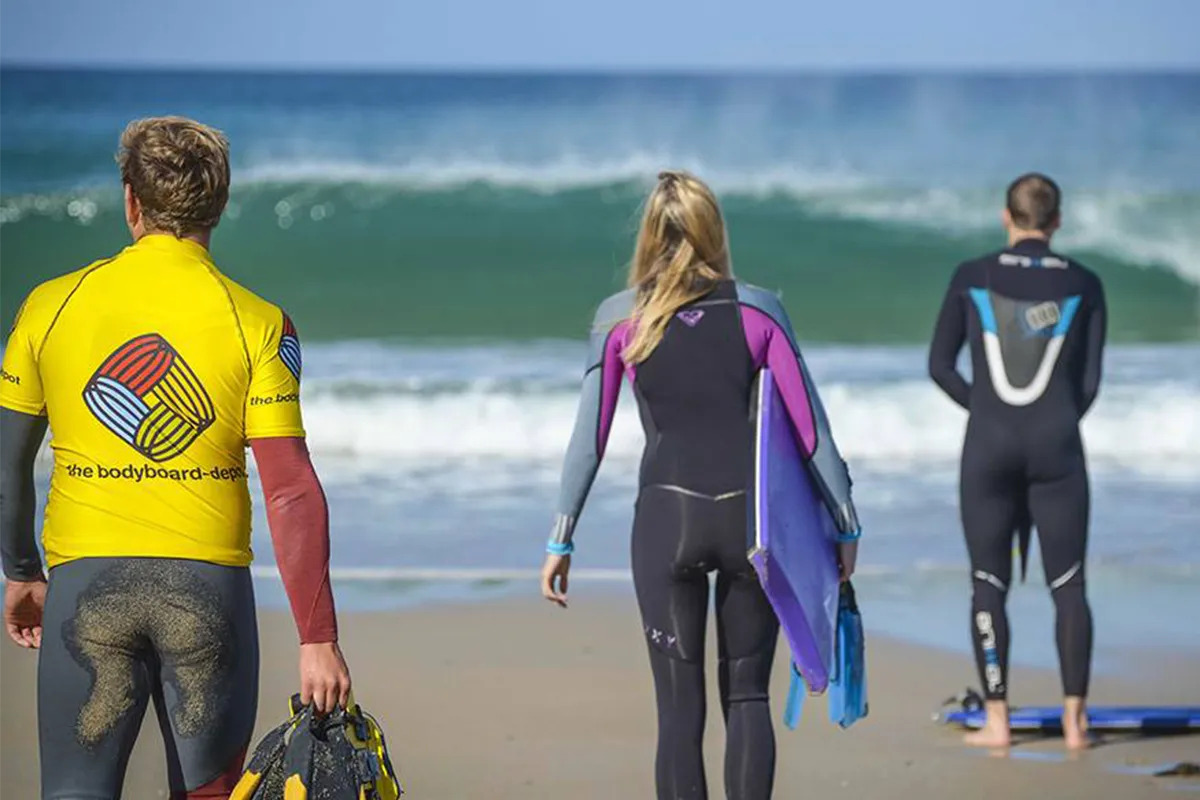Finding the right bodyboard for you!
Finding the right bodyboard shouldn’t be guesswork. I’m Rob Barber, founder of Bodyboard Holidays, and after coaching everyone from complete beginners on our Newquay Weekends to advanced riders in the barrels of El Salvador, I’ve learned that the perfect board is different for every rider.
The key is understanding how different features actually affect your performance in the water. Every design choice, from tail shape to core material, changes how your board feels and responds. When you know what each element does, choosing becomes much clearer.
This guide is based on real experience from coaching thousands of riders across every type of wave imaginable, from the artificial perfection of wave pools to the raw power of tropical beach breaks. I’ll explain exactly how different features work, what suits different conditions, and most importantly, how to find what’s right for your style and local waves and I hope to cut away a lot of the confusing jargon.
Whether you’re about to buy your first proper board or you’re looking to dial in your quiver, this is everything you need to make the right choice. Honest advice based on years of testing and coaching that’ll help you get on the best board for your bodyboarding.
Let’s get started.
How do you choose the right bodyboard?
The best way is through trial and error by testing different shapes, tails, cores and sizes until you find what works for your height, weight and style. Smaller boards suit bigger, punchier waves for manoeuvrability, while larger boards perform better in smaller surf for speed and float. Features like bat tails, Surlyn slicks, Polypro cores and stringers all influence speed, flexibility, control and durability.
Choosing the right bodyboard can feel overwhelming with so many shapes, sizes and features flooding the market. From bat tails vs crescent tails to Polypropylene (PP) vs Polyethylene (PE) cores, every design choice fundamentally changes how your board feels under your chest and performs in the water.
In this guide, I’ll break down the key factors that matter most, drawing on years of experience coaching at The Wave Bristol, in Costa Rica, El Salvador, Sumatra and beyond. Whether you’re just starting out or hunting for the perfect custom board, this blog will give you the clarity and confidence to make the right choice.
At Bodyboard Holidays, we’ve tested hundreds of boards across every type of wave imaginable. The truth is, there’s no single “perfect” board for everyone. But there is a proven method to find your ideal match.
The Golden Rule: Try Before You Buy
The best bodyboard for beginners and experts alike is discovered through hands-on testing. This cannot be overstated. I’ve seen countless riders struggle with boards they bought online without ever feeling them in the water.
Here’s the smart approach:
- Attend coaching weekends and demo events where you can test multiple boards back-to-back
- Swap boards with mates in the water during sessions
- Take advantage of events like our Hubboards Weekend at The Wave with Jeff Hubbard, where the latest designs are ready to ride
- Don’t be afraid to challenge your assumptions about what you think you prefer
I’ll be honest, I resisted bat tails for years, convinced crescents were superior for my style. One quick swap with a mate in decent surf completely changed my perspective. Sometimes you need to get out of your own way and actually feel the difference.
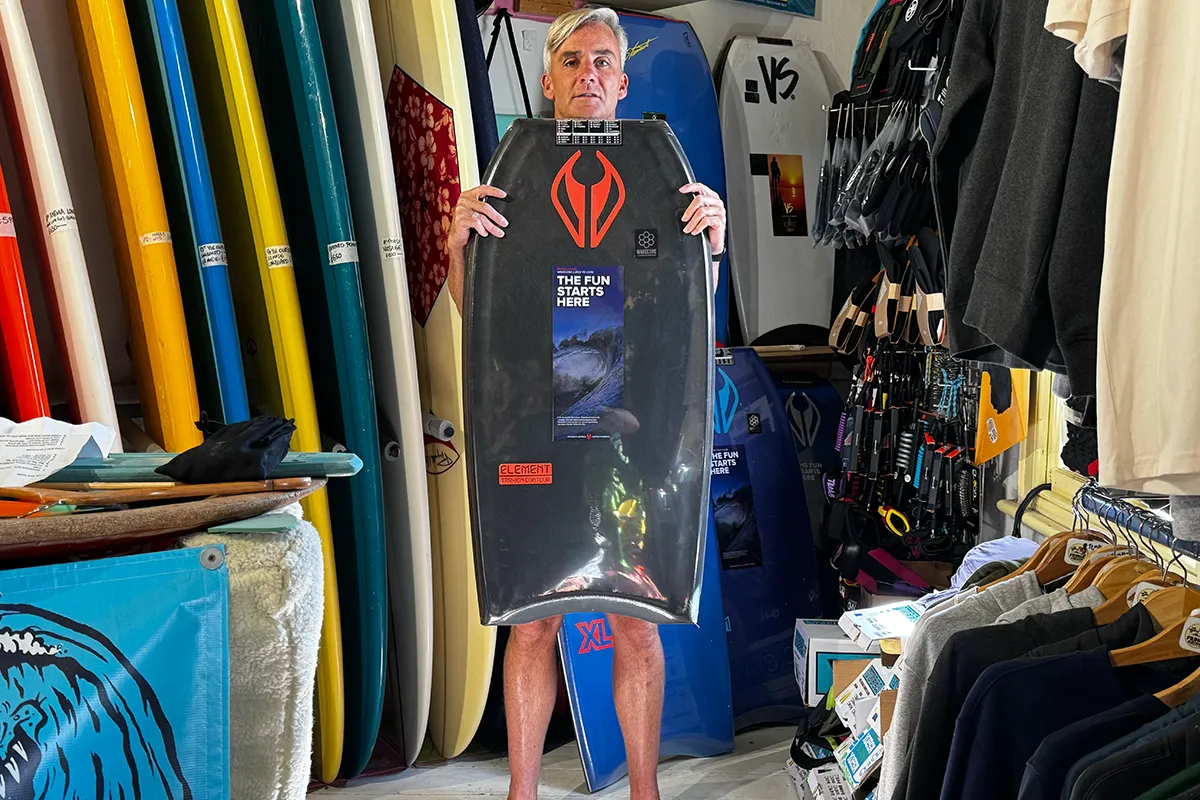
Bodyboard Size Guide: Finding the Right Fit
What size bodyboard should I get for my height? This is hands down the most common question we receive, and getting size right is absolutely crucial for performance.
The Traditional Method vs What Actually Works
The old “floor to belly button” measurement gives you a starting point, but here’s what really determines your ideal size:
Your board should sit between your chin and top of your knee for general guidance, but wave conditions and riding style matter more than rigid measurements.
Smaller boards work best in bigger waves:
- Significantly more manoeuvrable through critical sections
- Easier to duck dive under breaking waves
- Better for hitting the lip with precision and completing spins
- Less board to control in powerful surf, means speed management is easier
Bigger boards excel in smaller surf:
- Extra buoyancy keeps you moving in weak waves
- More speed across flat sections and through reforms
- Better paddle power to catch waves early
- Superior glide over mushy sections
I ride a 42.5 inch board for my build most of the time, but I’ll size down to 41 inches in powerful surf and up to 43 inches when it’s small and weak. The key is matching your board to the conditions you’ll be riding most, not just your height and weight. For more information and check out our full bodyboard size guide blog post.
Pro tip: Your fitness level matters too. Stronger paddlers can handle larger boards more effectively.
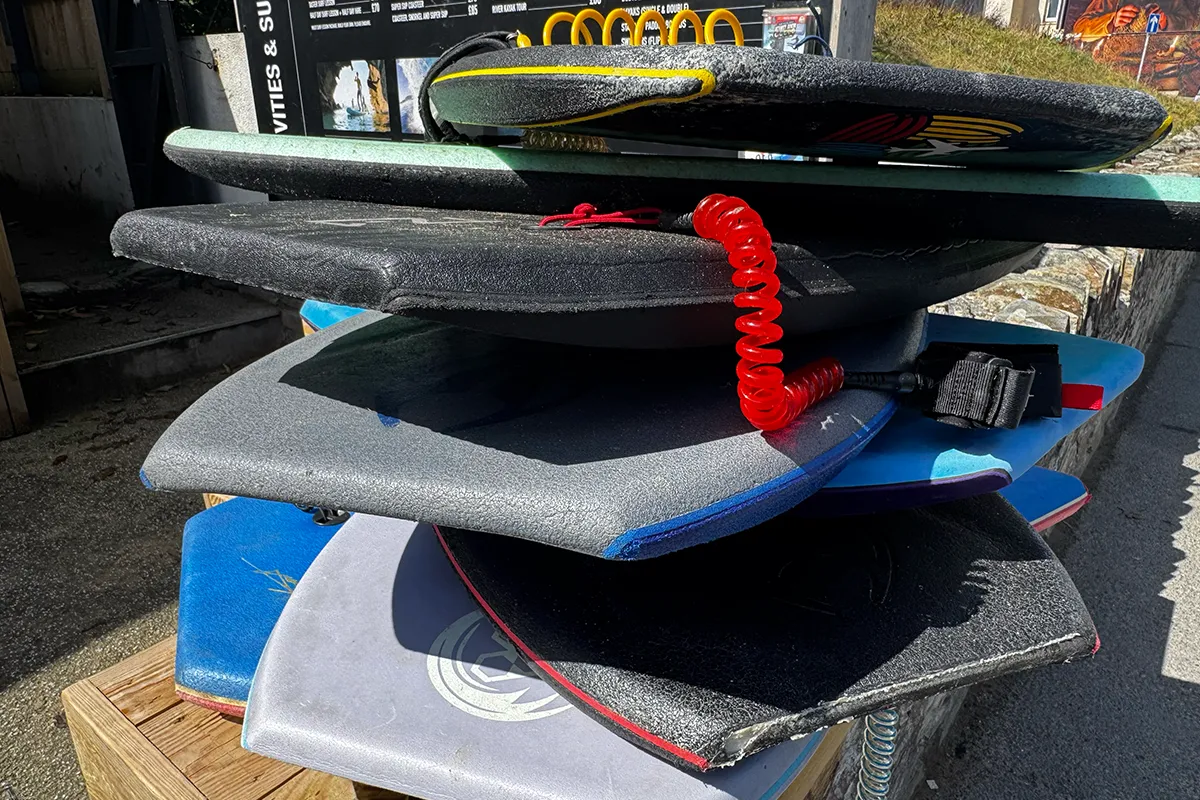
Advanced Sizing Considerations
The Wide Point
The widest point of any bodyboard is measured rail-to-rail and it affects both flotation and turning ability. A wider board will offer more flotation but will be harder to turn. Over the past few years boards have become narrower, most are less than 22 inches, to accommodate harder and sharper turns in critical situations.
Nose to Wide Point
This is the distance from the nose to the board’s widest point – it determines the overall plan shape and template of your board. A higher wide point creates more surface area around the nose and offers more stability if you ride prone. A lower wide point narrows this area which increases manoeuvrability. A low wide point is commonly preferred for drop knee riding, as the DK rider can drive with their knee on the widest point of the board at the rail edge.
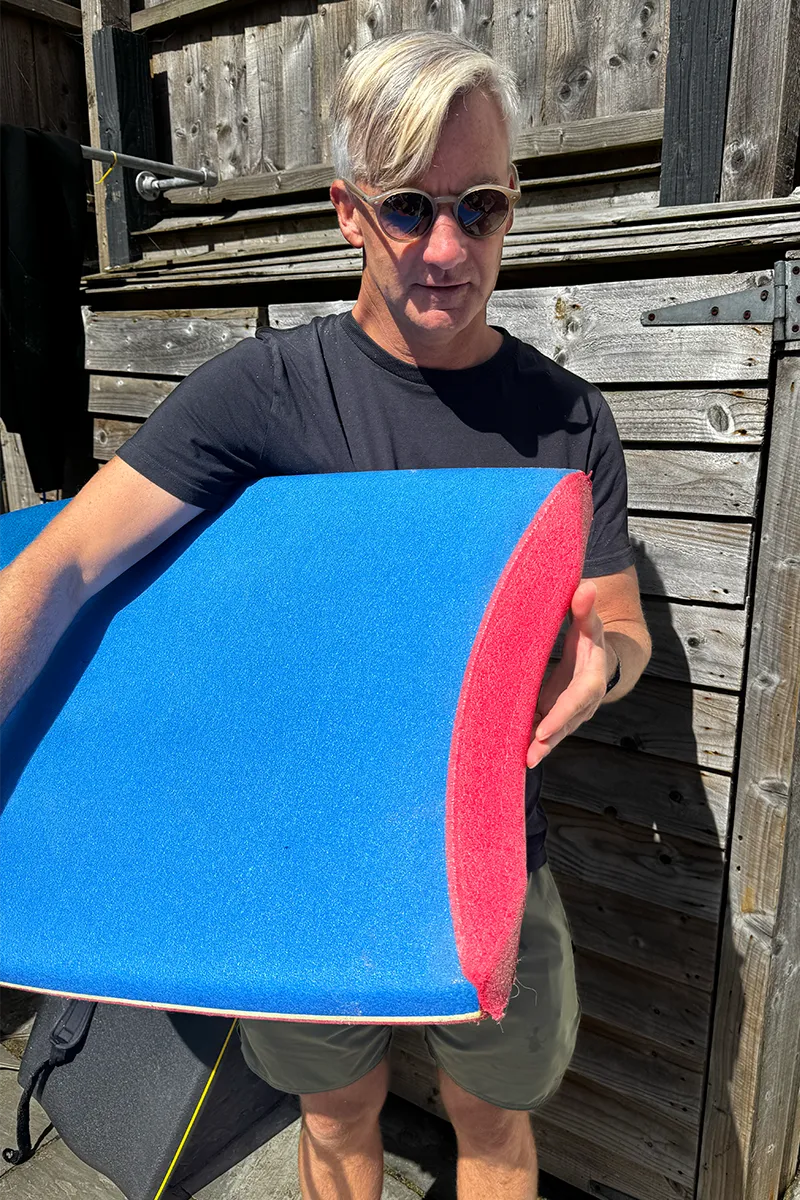
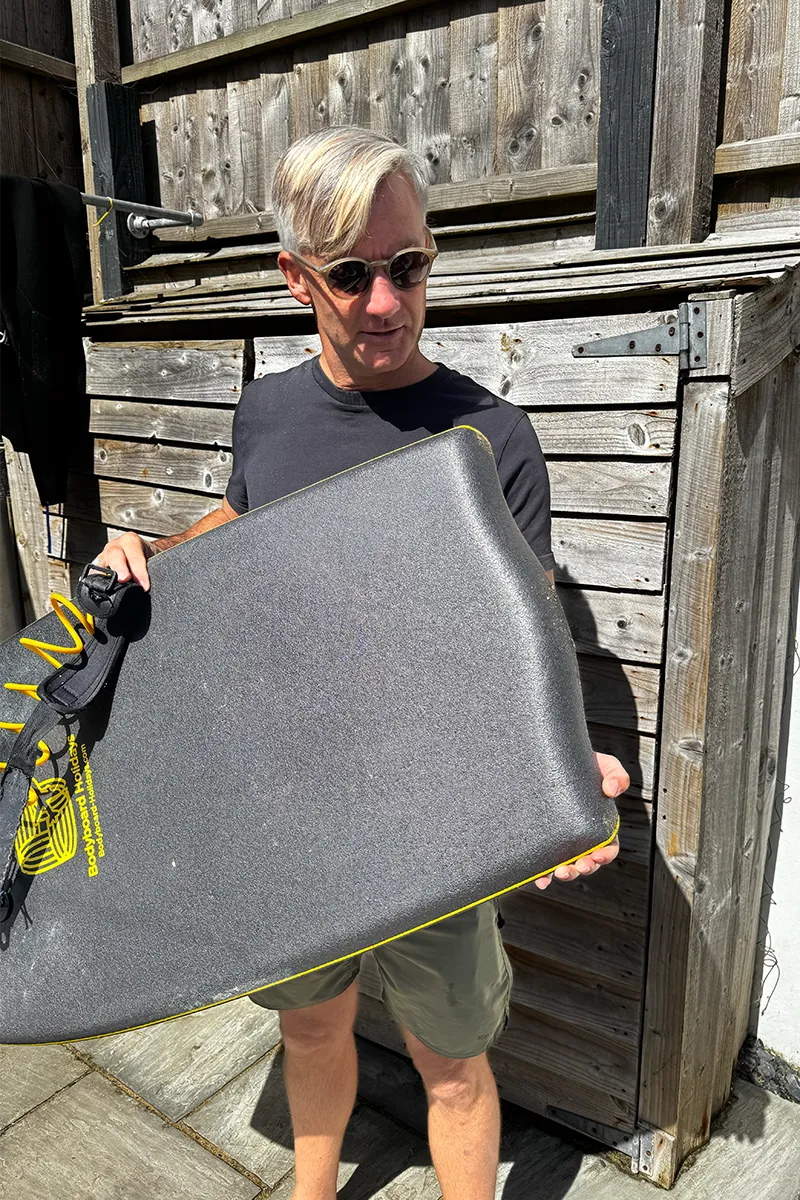
Bat Tail vs Crescent Tail: Which Is Better?
This debate has split the bodyboarding world for decades, but both designs have clear, proven advantages in different situations.
Crescent Tail Bodyboards
The most widely used tail design is the clipped crescent tail. As the name suggests, it forms a wide U shape, which puts more of your body in contact with the water’s surface. Why crescents remain popular:
- Superior for drop knee riding because the curved tail provides more control through turns. But full crescents (unclipped) are the preferred choice for serious DK riders.
- Better hold in steep wave faces especially in powerful, hollow waves
- Great for groms or beginners, as they make it easier for you to position your hips on the back of the board to catch waves
- Also comfortable while you paddle back out
- Have the best bite or purchase of all tail designs because they allow you to engage the rail edge more easily while riding the face of a wave
- The tail peg (the back corner of the board) displaces water from wave face allowing you to track or trim across it
- The preferred tail type for riders focusing on bigger waves and those totally addicted to tube riding
- Versatile performance across varied wave types
Bat Tail Bodyboards
Are bat tail bodyboards better for speed? Absolutely, and here’s why:
- Designed for heavier riders or shredding smaller waves
- Extra surface area creates significant lift keeping you higher in the water
- Produces more lift towards the back of the board, allowing more speed and manoeuvrability
- Perfect for UK waves and wave pools where you need every bit of performance from weaker surf
- First choice for many top European riders and UK riders – who even confess in hushed circles that it makes bodyboarding easier
- Popular belief that bat tails help you ride out of moves more easily and they generally offer a smoother ride through turns
- However, in bigger more sucky waves they can become a little twitchy and lose some of their high-line holding power
My recommendation: If you mainly ride mushy UK waves or spend time at wave pools, definitely try a bat tail. The performance difference in weaker surf is immediately noticeable. It’s certainly a good summer option for British shores, and prone riders who never shred in the drop knee position should definitely consider it. However, for consistently powerful surf or if you’re passionate about drop knee riding, crescent tails still have the edge for control and drive. Most riders will have a crescent tail and a bat tail board in their quiver.
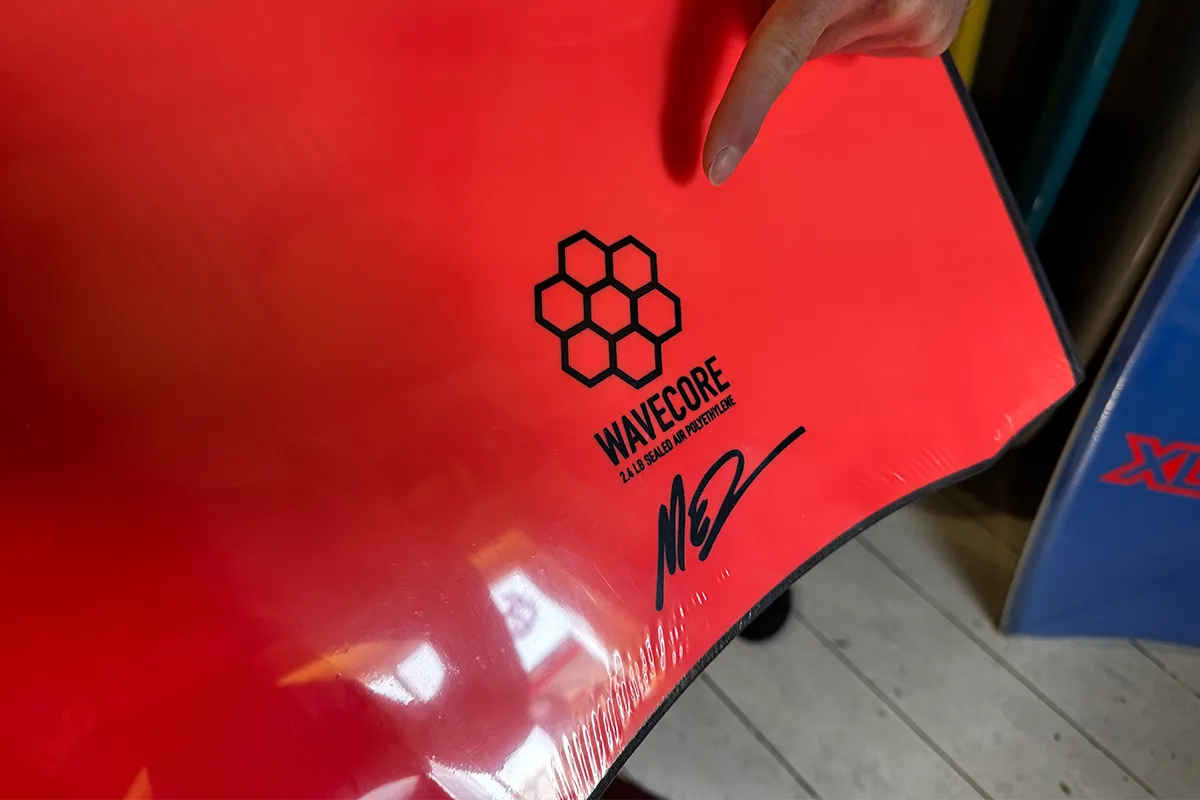
Bodyboard Core Types Explained
The core is genuinely your board’s engine room. You can’t see the actual core of a bodyboard, but it’s the most important element. It defines a board and, used in the right circumstances, will allow you to progress, enjoy the sport and reach your full potential. Get the core type wrong and there’s a good chance you’ll never become best pals. It just won’t feel right.
The type of foam used in each core determines the bodyboard’s performance in the water. So, think about the type of conditions in which you’ll be using your board. Consider water temperature, wave sizes, wave types and your own dimensions.
PP vs PE Cores: The Critical Difference
There are two main types: polyethylene known as PE and polypropylene known as PP. Though different companies use various names to put their mark on what is essentially the exact same material, these are the core building blocks representing each end of the spectrum – stiff at one end and flexible foam at the other.
PP Core (Polypropylene):
- Lightweight and noticeably stiff when you flex it
- Best bodyboard for warm water (above 18°C consistently)
- Maintains excellent flex and recoil in tropical conditions
- Premium option with noticeably better performance
- Faster ride with more speed out of turns
- Has the ability to recover its original shape extremely well, preserving its lifespan over and above a PE board
- Can become too stiff in very cold water
- Noticeably more buoyant than PE
PE Core (Polyethylene):
- Most common core used in bodyboards, especially in the cooler waters of UK and northern Europe
- Heavier but significantly more flexible
- Perfect for cold water bodyboarding where it stays flexible
- Maintains consistent feel in UK temperatures year-round
- Has far more flex which offers more control
- Has the ability to bend and shape itself into the wave face more easily
- Softer feel that some riders prefer for comfort but at the expense of speed compared to PP
- In bigger sucky waves, like shore breaks, some riders prefer the increased flex that PE cores offer
Low-Density PP Cores offer the best of both worlds for UK conditions. Brands use different names for low density PP core boards. NMD and VS call them NRG cores, whereas Found call them Paradox cores. For many riders this design offers the best of both worlds; a light board with good buoyancy and flex when the water is cool, while holding its own in warm water without turning to jelly.
EPS Cores
An expanded Polystyrene core, or EPS, most commonly features on entry level or beginner bodyboards. This stiff but lightweight foam provides the ideal platform for diving onto broken waves and riding them to the beach. It offers great buoyancy and a reasonable amount of flex. Perfect for first-timers tackling their first waves, but don’t expect it to last as long as a PE or PP board.
Stringers, Mesh and Flex: The Support System
Why do bodyboards have stringers? If you’re really serious about getting into bodyboarding, the stringer is an essential element with which you need to get familiar.
Stringers are tubes or rods made from carbon fibre or fibreglass that run through the board core. Stringers not only make boards last a lot longer, they also increase performance.
Single stringers provide the ideal balance between flex and strength. In cooler waters, a single central stringer usually of medium stiffness is the norm. A single stringer is enough for most riders, as it keeps the board rigid when paddling but allows it to flex when riding a wave.
Double stringers are often used on boards that have HDPE bottom skins, as this helps to keep rigidity and recoil. Some drop knee riders prefer double stringers as they feel that the flex that the board receives when they are bottom turning can recoil with more energy if there are two stringers.
A recent fad was the Interchangeable Stringer System (ISS). The ISS allows you to change stringers to suit different wave conditions and water temperatures. The soft stringer is suitable for cold water, the mid stringer for cold to mid temp water, the stiff stringer for mid to warm water and the carbon fibre stringer is ideal for warm water. This production has been discontinued but you will still see it on some old models.
Whichever design you choose, always bear in mind that generally, more stringers mean more weight and that a flexible board will be more responsive and easier to control in steeper tubing waves. A more rigid board will be faster, but generally a little harder to control. Interesting fact, stringers are often made of the same material of gold clubs and fishing rods!
Mesh and Memory
Mesh is a wire-like plastic material that sits between the slick and the core. It enhances projection and makes boards more durable. It also cushions the stress boards receive when landing aerial moves. I generally prefer boards that maintain their natural feel rather than over-engineered stiffness. Interesting fact, mesh is the same material is the same material as you will see in some garden fencing!
Flex and Recoil
Flex and recoil is something you’ll hear a lot of bodyboarders talk about. When looking for a board you need rigidity for paddling out, but you also need flex to bottom turn and cut back. The speed with which your board recoils or reforms to its original shape creates projection. Effectively this is speed – what all bodyboarders crave! The ability of a board to return to its original shape is called memory.
The older and more worn a board becomes the more it loses its ability to recoil. It becomes slower and loses its memory. At this point, it’s time for a new board.
No stringer boards appeal to riders who want maximum flex and a very organic feel. Bodyboard Holidays Guest Pro Rider Vicki Reale famously prefers this setup, prioritising natural board movement over structured support.
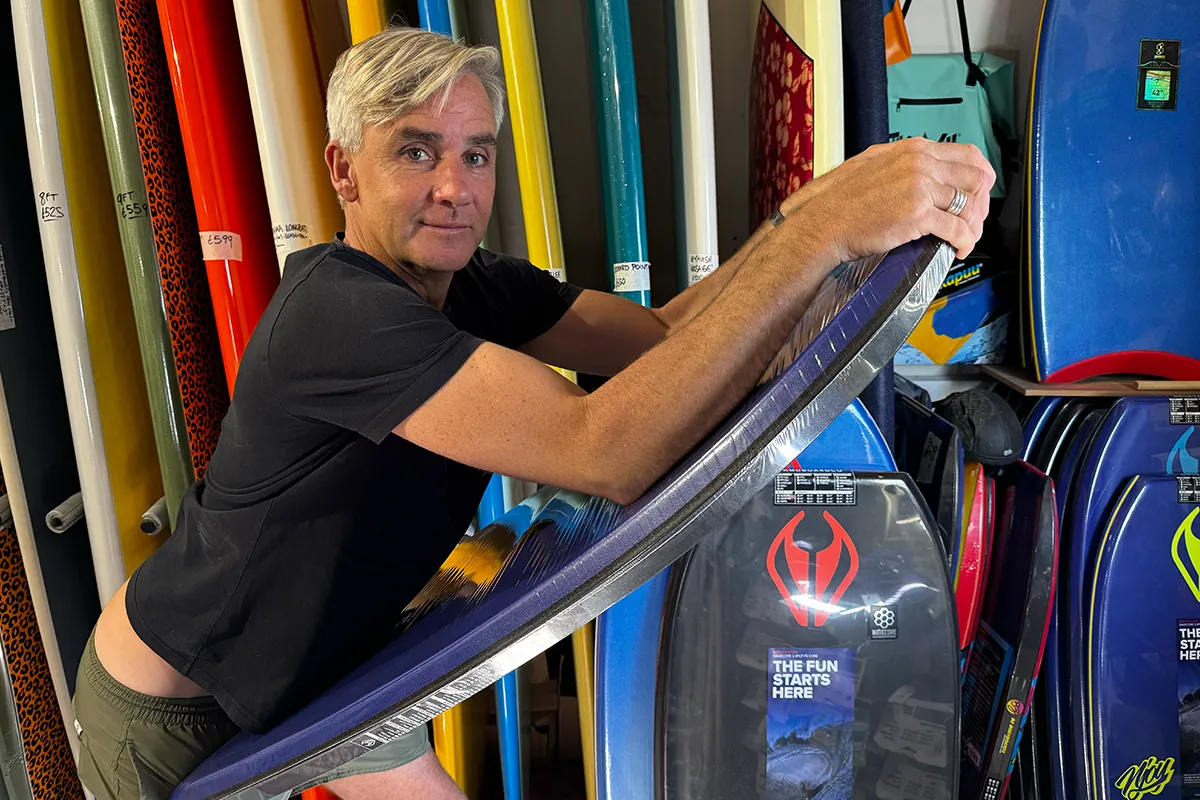
Do Slick Materials Make a Difference?
Absolutely yes. The slick is the underneath material of a bodyboard which is in direct contact with the water whilst riding waves. The slick material on your board’s bottom fundamentally changes how it performs in the water, and most riders underestimate this impact.
Surlyn vs HDPE Slicks: The Performance Gap
There are two types of material commonly used for slicks: Surlyn and HDPE (high density polyethylene).
Surlyn Slick (my personal choice and recommendation):
- The most common material used by bodyboard manufacturers (it’s the same plastic used to cover golf balls!)
- A rubber composition of ethylene resins and copolymers which have elastic properties
- Noticeably faster through the water
- Makes the board responsive and recover to an original shape when flexed
- Provides superior projection through waves
- More durable long-term, maintaining performance characteristics
- Increases board longevity and prevents creases
- Due to its elasticity it’s the more expensive of the two slick materials, but it’s the preferred skin of the world’s leading bodyboarders
- Superior projection and speed out of turns
- You can crease a Surlyn slick board and it still be useable, some even think it improves them!
HDPE Slick:
- Cheaper initial purchase cost
- In terms of look and feel there’s little to separate it from Surlyn
- Tend to appear on entry-level, to beginner and intermediate boards
- Adequate performance for beginners learning basics
- Can become sluggish and less responsive over time
- Will crease from heavy landing and it then looses it recoil and memory properties
- Unless you’re just starting out it’s usually worth paying that little extra for a Surlyn
If you’re serious about improving your bodyboarding, invest in Surlyn. The speed and projection difference is immediately apparent from your first wave, and the longevity makes it better value over time.
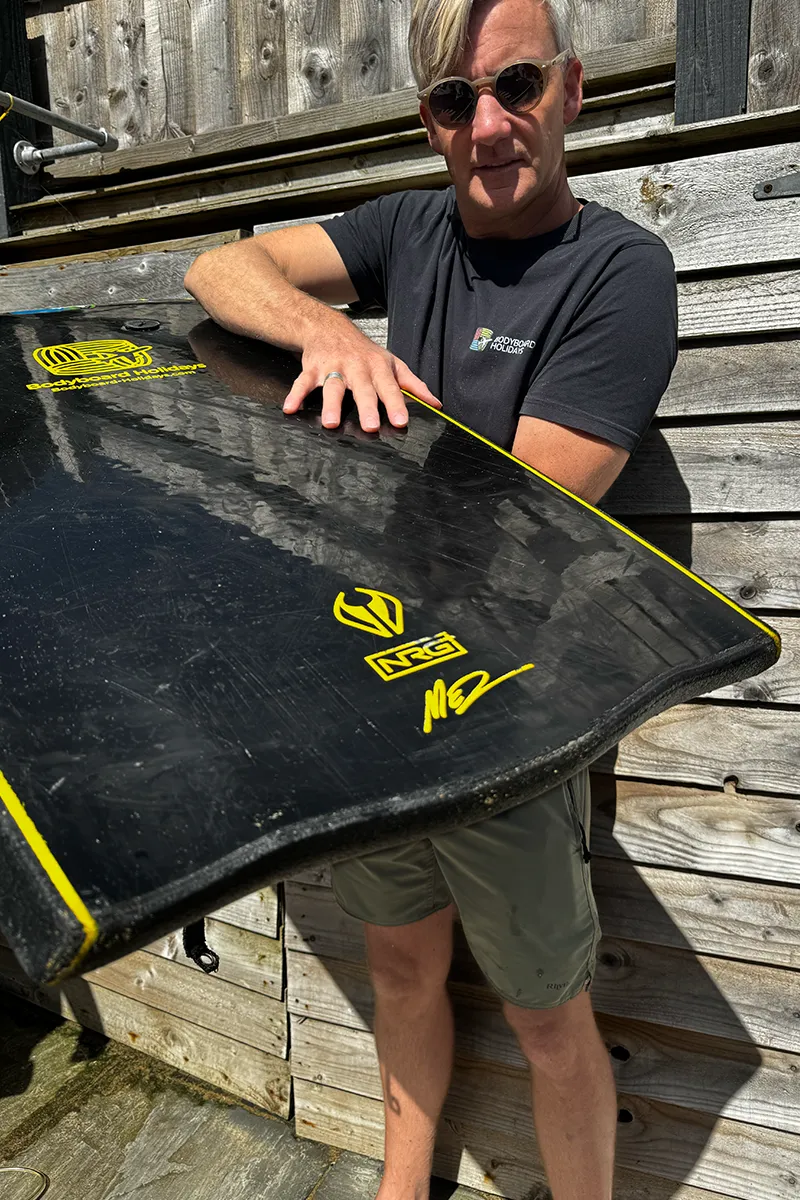
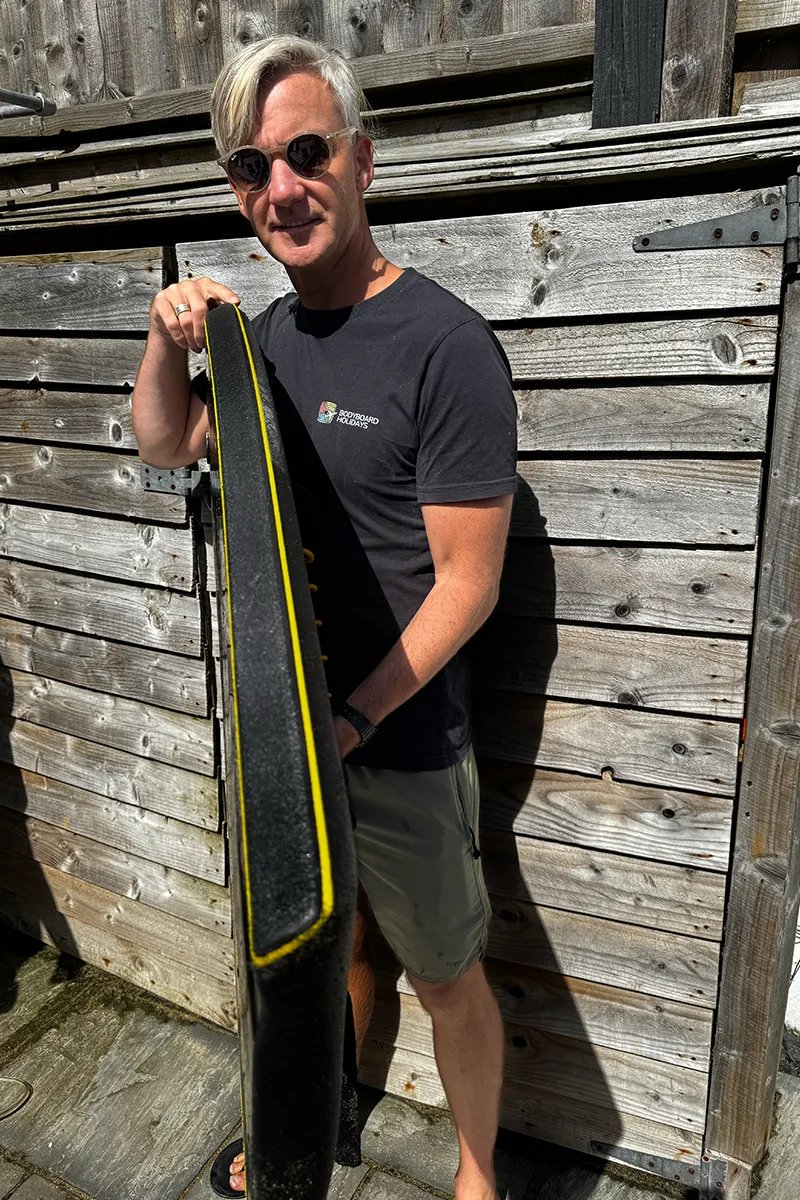
Additional Bodyboard Features to Consider
Decks
The deck is the material on a bodyboard that you lie on. The usual configuration for deck material is 8lb (density per inch) PE (polyethylene). PE decks are soft and flexible, but just like PE cores, after time they will wear out. Indentations and creases in areas under pressure also develop quickly in PE decks.
The alternative to a PE deck is known as crosslink, a thinner 6lb cell structure that absorbs less water whilst being more durable, but it tends to be far stiffer. This is often used on boards in the £100 and under price bracket. If you purchase one of these, be aware that it will require more wax for traction due to its vinyl feel and touch.
Contours
Whilst contours enhance the look of your board, they’re specifically designed to increase flex, response and control. They offer extra grip, comfort and help you hold on through big duck dives or heavy landings. They can make a terrific difference during hairier rides. Riders that are new to bodyboarding can also find that they help to enhance their ability to put their hands and elbows in the correct place.
Rails
Rails are the side edges of your board that run from the nose down to the tail. There are two sections to a rail: the top part of the board edge, which is called the chine and the bottom part which is called the rail.
Two different rail designs feature in most bodyboards: the 60/40 and 50/50. These numbers relate to how much of the chine is at the top and how much of the rail is at the bottom.
A 60/40 rail means that 40% of the chine connects to the deck whereas 60% of the rail is in direct contact with the water. This style of rail is best for maintaining control on bigger, more powerful waves and is traditionally the most common option.
50/50 rails are equally divided. They offer more speed as it’s easier to disconnect from the wave face. Some signature boards designed by professional riders also have rails with slightly different ratios, such as 70/30 or 55/45.
The Nose
The nose of your board is the front part at the top and its width affects your board’s manoeuvrability. A wider board such as one between eleven and thirteen inches (suited to prone riders) will be more stable. Whereas a narrower one which could be anywhere from a rounded nose to ten inches (preferred by drop-knee riders) will be more loose and manoeuvrable.
If you choose a board too wide for your riding style, you’ll start to lose speed. Similarly, choose a board with too narrow a nose and you’ll have a hard time controlling your board. Most boards have a very similar sized nose, so don’t stress about it too much.
Nose Bulbs
Nose bulbs are amongst the many names given to the finger grips on the hull side (bottom) of your board. Designed to increase finger and hand control, nose bulbs also increase strength and durability in this area of your board. Look out for these features if you love riding heaving slabs and taking heavy drops. They’re a really functional design feature, and once you’ve got used to them you will never want a board that doesn’t have them.
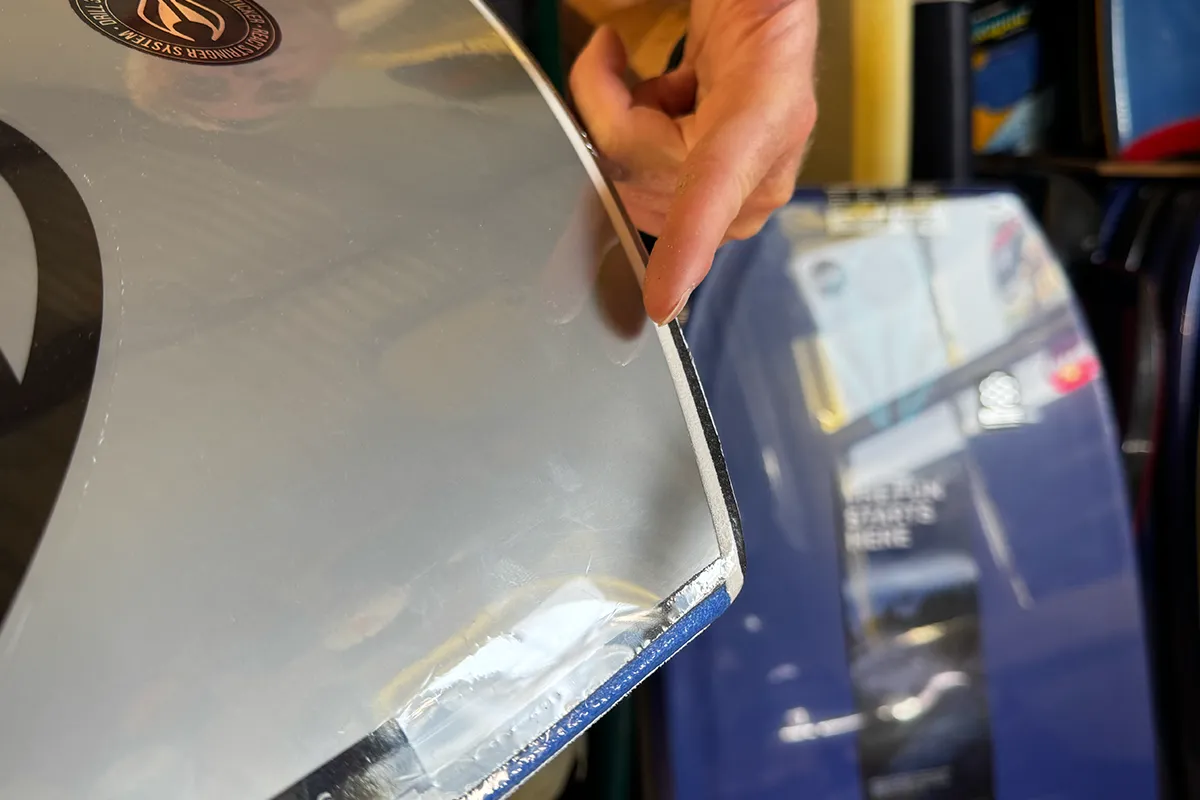
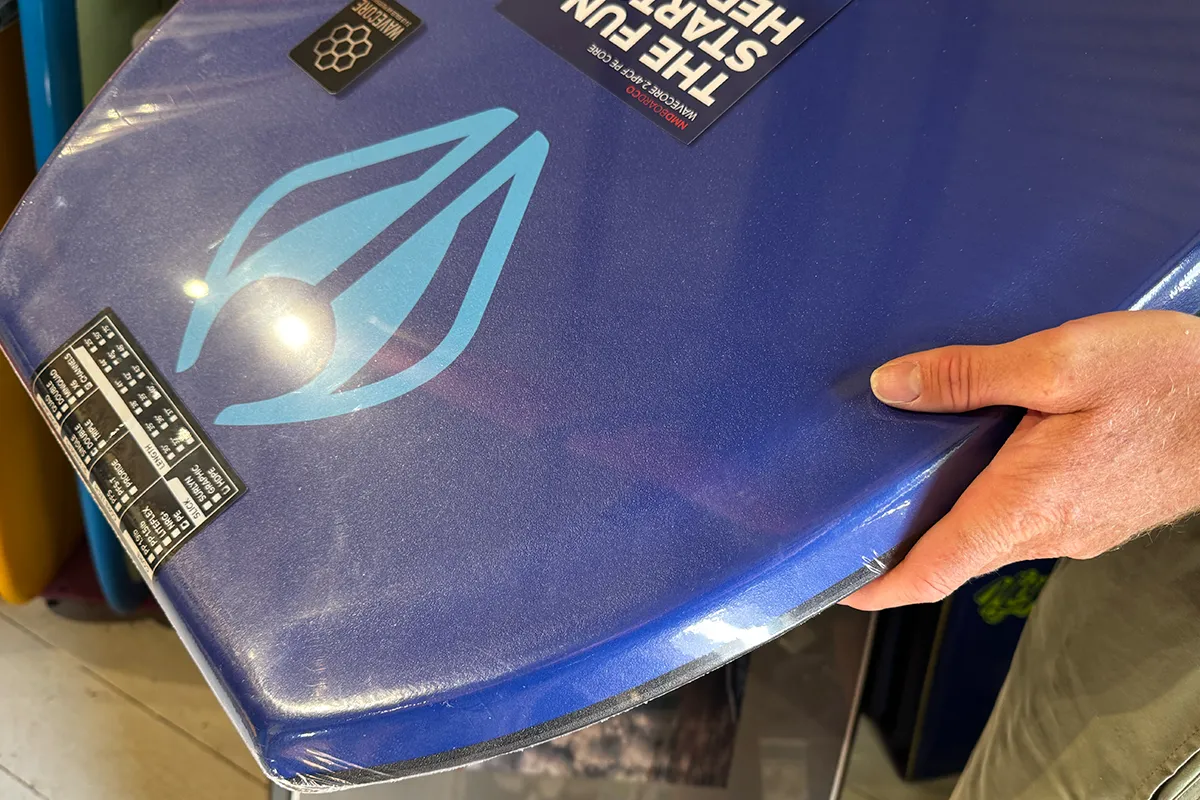
Are New Bodyboard Features Gimmicks or Game Changers?
Every season brings flashy new technology and design innovations. Here’s how to separate genuine advances from marketing hype:
Proven Performers That Actually Work
Channels and Concaves
Channels are small grooves on the bottom of your slick. They help hold the wave face much the same way a fin works for a surfboard, enhancing directional control and movement. Most channel designs feature a narrow entry for water at the front of the bodyboard with a wider exit at the back. This creates an increased surface area so your board holds the water better through bottom turns and rail transitions.
A design feature known as a Concave is a large channel running half the length of the bodyboard through to the back of the hull. It usually starts approximately 20-25 inches from the nose with a gradual arc/channel through to the tail. Concaves add greater control and are designed to maximize down-the-line speed and drive. Damian King pioneered the design and credits his first world title to this feature.
Quad concave systems have moved from experimental to proven. Initially dismissed by many riders (myself included), they genuinely create lift and speed, especially effective in heavy waves where the water flow benefits are most noticeable.
ISS stringer systems represent clever engineering, allowing you to swap stringers for different conditions. While not revolutionary, they offer real benefits for riders who surf varied climates regularly.
Custom bodyboards become worthwhile for advanced riders with specific needs. The ability to fine-tune, dimensions, materials, colours and features to your exact preferences and local conditions can make a meaningful difference to performance.
Worth Watching: Emerging Technology
Sci-Fi by Hubboards is next on my personal testing list. What makes it interesting is the genuine pro rider development process. When someone like Jeff Hubbard spends months refining a design in world-class waves, it’s worth paying attention.
My golden rule: If the technology wasn’t developed by actual pro riders in real waves, approach with healthy scepticism. Marketing departments love flashy features, but ocean-tested innovation by experienced riders usually delivers genuine benefits.
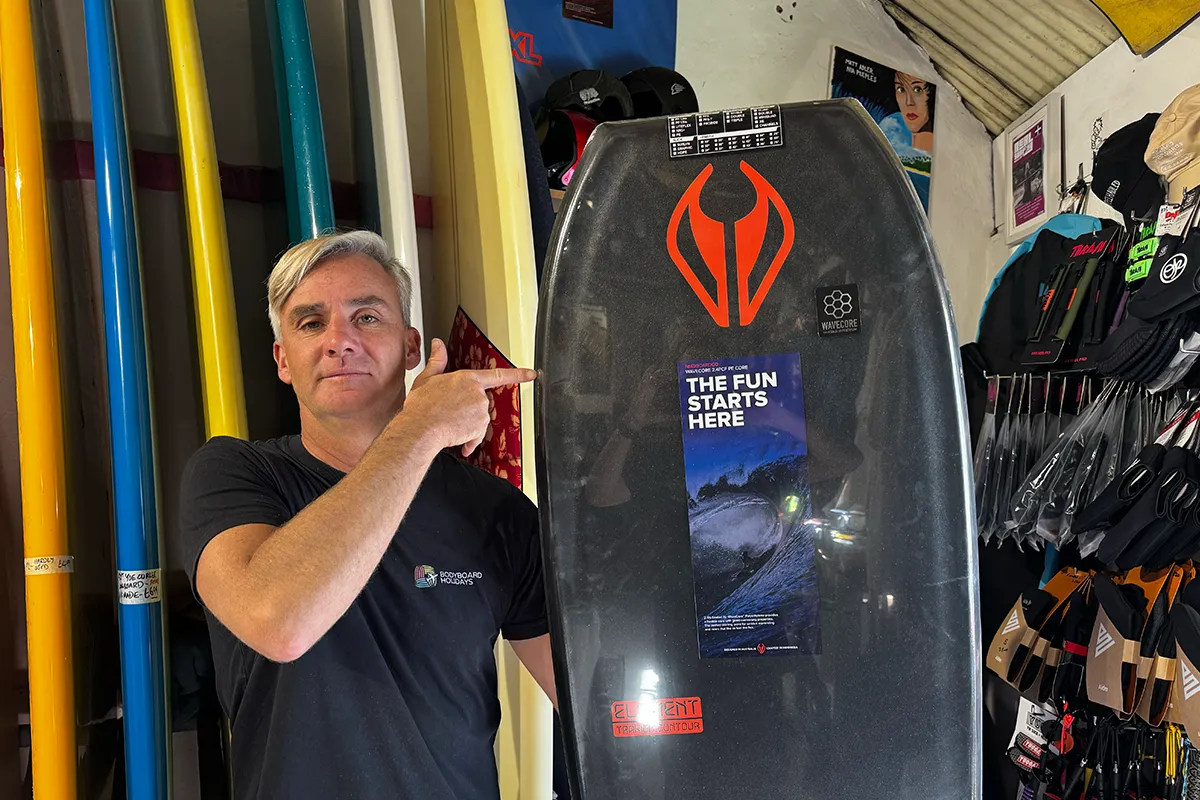
The Best Bodyboards for UK vs Tropical Waves
Different waves absolutely demand different approaches. What works perfectly in Costa Rica can feel completely wrong in British surf.
Best Bodyboard for UK or Cold Water Waves
Essential features for our conditions:
- Bat tail for extra lift in typically weaker surf
- Low-density PP or PE core suited to our water temperatures
- Surlyn slick for maximum speed through flat sections
- Simple, reliable channel systems that work across varied conditions
- Slightly larger size for additional paddle power in mushier waves
Tropical Wave Bodyboards
Optimised for powerful, warm water surf:
- PP core essential to maintain performance in consistently warm water
- Quad concave systems shine in powerful waves where water flow benefits are maximised
- Precision sizing possible because consistent wave power allows smaller, more manoeuvrable dimensions
- Advanced channel systems worthwhile in waves with enough power to activate their benefits
The difference isn’t just preference – it’s physics. Warm water affects core materials differently, and powerful waves allow design features to work that would be ineffective in weaker surf.
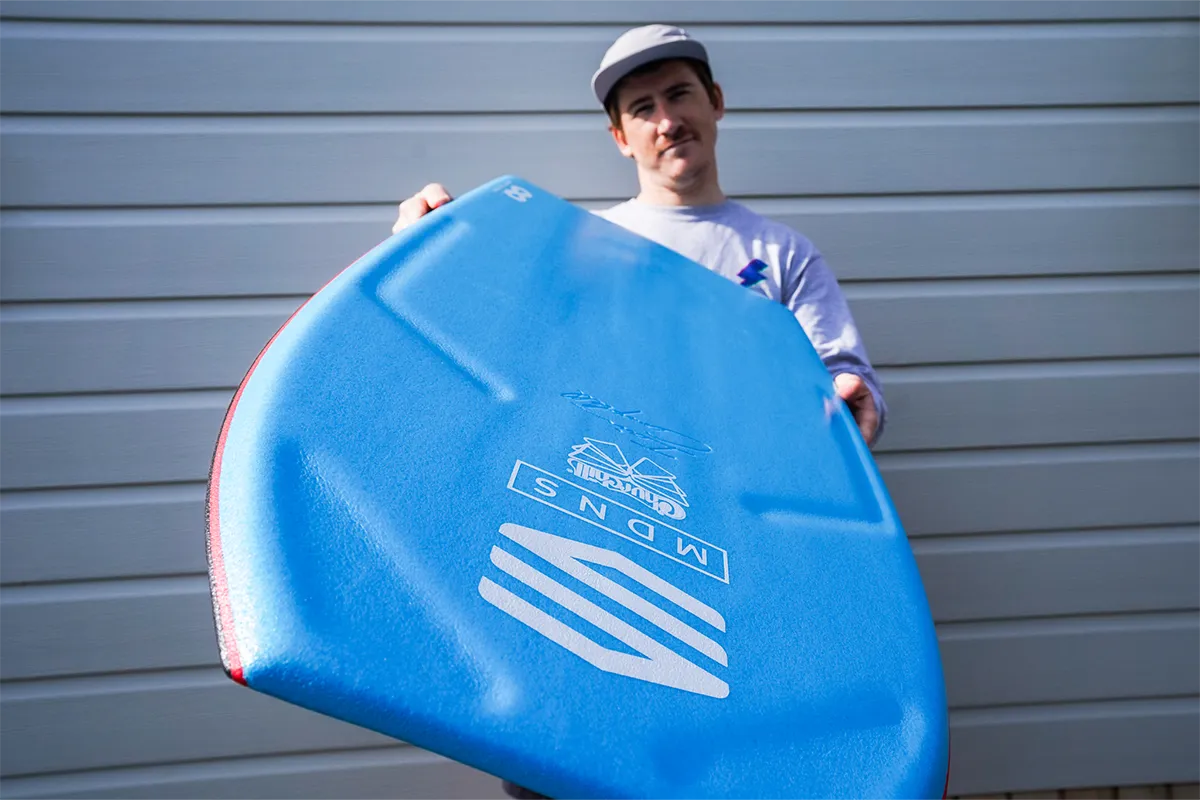
Learn from the Pros: What Elite Riders Choose
Every top rider has developed specific preferences through years of testing and competition. Their choices offer valuable insights:
Jay Reale rides thicker boards with pronounced scoop noses and extra rocker, optimised for his drop knee mastery and the powerful waves he typically surfs.
Vicki Reale deliberately chooses no stringer setups, preferring maximum flex for her fluid, stylistic approach to bodyboarding.
Iain Campbell works with shapers on cutting-edge custom designs that push performance boundaries, often testing concepts that later appear in commercial boards.
Jeff Hubbard constantly refines shapes with Hubboards, focusing obsessively on speed and control elements that benefit both recreational and competitive riders.
The key insight: Each pro’s setup reflects their specific style, local conditions and performance priorities. Don’t copy blindly, but understand the reasoning behind their choices.
Take advantage of today’s access: Message pros on social media, watch detailed brand videos, ask specific questions. Most elite riders are genuinely happy to share advice and insights about equipment choices.
FAQs: Your Bodyboard Buying Questions Answered
What size bodyboard should I get for my height?
Start with the chin-to-knee measurement, then adjust based on your local conditions. Bigger waves = smaller board for manoeuvrability. Smaller waves = larger board for speed and float.
Are bat tail bodyboards better for speed?
Yes, the extra surface area creates noticeable lift and drive across flat sections. Particularly beneficial in weaker surf conditions.
What's the difference between PP and PE cores?
PP cores are stiffer and lighter, ideal for warm water. PE cores stay flexible in cold water but are heavier. Low-density PP splits the difference for variable conditions.
Why do bodyboards have stringers?
Stringers add structural strength and recoil, preventing the board from folding while maintaining responsiveness. They’re the spine of your board.
Are quad concave boards worth it?
Yes, in powerful waves they create genuine speed and hold benefits. Less noticeable in small surf, but proven effective in heavier conditions.
What's the best board for drop knee riding?
Crescent tails with slightly more rocker in the nose provide superior control and drive for drop knee manoeuvres.
Should beginners start with a cheap board?
Avoid supermarket boards that will hinder learning. Choose an entry-level board with proper construction that won’t limit your progression.
What's the best bodyboard for UK waves?
Bat tail design with PP or low-density PP core and Surlyn slick. Sized slightly larger for paddle power in weaker surf.
Do pros really use custom boards?
Absolutely. Elite riders like Jeff Hubbard and Iain Campbell work directly with shapers to fine-tune every aspect of their equipment to their exact specifications and local conditions.
Where can I try different boards before buying?
At our coaching weekends you can test multiple designs with expert feedback, making direct comparisons in real waves with professional guidance and Bodyboard Holidays offers a hire service with a huge range to choose from.
CONCLUSION: Finding Your Perfect Board
Choosing the right bodyboard isn’t about finding one perfect answer that works for everyone. It’s about understanding how different features affect performance, then testing systematically to discover what works for your style, local conditions and performance goals.
From tail shapes to core materials, every feature makes a measurable difference to how your board feels and performs. The key is keeping an open mind, actively testing different setups, and learning from experienced riders and coaches who can guide your choices.
Remember: the perfect board for you might surprise you. I spent years convinced I knew exactly what I wanted, only to have my assumptions challenged by actually trying different designs. Stay curious, keep testing, and trust what you feel in the water over what you think you should prefer.
Try Boards with Expert Guidance
Ready to discover your ideal ride? The fastest way to find your perfect board is testing different shapes in real waves with professional guidance.
Join one of our Weekend Coaching Events or our Portugal or Bali trips, where you’ll have access to a full quiver of boards from leading brands, expert advice from experienced coaches, and the opportunity to make direct comparisons in proper surf conditions.
This isn’t just about buying equipment – it’s about understanding how design choices affect your surfing and finding the setup that will genuinely elevate your bodyboarding to the next level. Take the guesswork out of choosing your next board!
